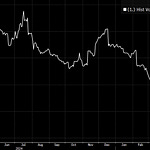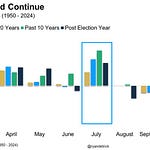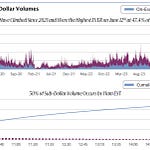This installment of The Pomp Letter is free for everyone. I send this email to our investors daily. If you would also like to receive it every morning, join the 50,000 other investors today.
To investors,
This week is shaping up to be one of the most historic in modern monetary history. Federal Reserve Chairman Jerome Powell is set to deliver a speech on Thursday that will outline a significant change in the way that the organization thinks about inflation and their annual targets.
This speech will be part of the Fed’s virtual conference that is replacing their traditional get-together in Jackson Hole, Wyoming. Rumors are Powell’s speech is titled “Monetary Policy Framework Review” and will specifically focus on increasing inflation as a means of creating a better economic environment. There is only one problem though — history tells us that decreasing inflation is not only better for the bottom 50% of Americans, but it is also creates a stronger outcome over the long run.
In order to understand why the upcoming decision is so important, we must first take a trip back in history to October 1979. Paul Volcker had been Federal Reserve Chairman for a mere two months, but he was quick to realize the errors of his predecessors. They had allowed, and even encouraged, high levels of inflation. Here is the St. Louis Fed’s summary of how bad the situation was at the time:
“The inflation rate, a mere 1 percent in 1965, hit 14 percent by 1980. Unemployment trended up from a low of 3.5 percent (annual average) in 1969 to 9.7 percent in 1982. The stock market was in the dumps. Oil prices jumped off the charts. Presidents Richard Nixon and Jimmy Carter became desperate enough to tinker with price controls, the results being disastrous.”
Paul Volcker immediately made a number of tough decisions upon assuming the Chairmanship. The first decision was to ignore the short-term impact of any monetary policy decisions and optimize for long-term economic strength. The second decision was to stop obsessing over a low interest rate environment, which shifted the focus to the money supply.

The impact of these decisions are hard to comprehend in today’s world of instant gratification. Volcker essentially took the hard road in the short-term, so the US economy could be healthier over time. The short-term difficulties included a transition from the easy/cheap credit environment to an expensive credit environment, prime lending rates were over 20%, unemployment reached double digits numerous times, and the dollar was severely weakened in foreign exchange markets. Ultimately, Paul Volcker oversaw two economic recessions before his policies had the intended impact of creating a prosperous market and economy.
Think about how difficult that would be in the current world. A Federal Reserve Chairman choosing to pursue the correct, yet unpopular, decisions. Leadership that optimized for long-term strength, rather than short-term pain mitigation. It is nearly impossible to fathom the idea that any politician or Federal Reserve member would be willing to oversee two separate economic recessions in order to put the United States back on track.
So what exactly happened once the United States got through the short-term pain? We had an incredible economic boom cycle starting in the 1980s and carrying through the 1990s. The economy had found solid footing. There was a direct relationship between Volcker’s decisions and the economic boom, stabilized prices, and general prosperity of the United States.
As I have learned more about Paul Volcker and the drastic measures he took, one paragraph from the St. Louis Federal Reserve stood out to me. Here is what they said about the lessons learned:
“For starters, ideas matter. Bad economic advice, much of it from economists, contributed greatly to policy mistakes in the pre-Volcker days. Keynesian economics had been in vogue by then for decades. This school argued that the government could tax and spend its way to full employment. Inflation was acceptable if it put more people to work. Thankfully, such thinking has been discredited today, although our economic models still need improvement.”
Read through that paragraph again. Keynesian economics had been in vogue. Government could tax and spend its way to full employment. Inflation was fine as long as more people went back to work. Sounds familiar, right?
My greatest fear is that the United States is about to make the same mistakes that we made decades ago. Rather than allowing the current economic reality of low inflation and high unemployment to naturally correct itself in the market, the Federal Reserve feels compelled to intervene. This interventionism is a natural human emotion — we feel like we lack control if we do nothing in uncertain times.
Remember though, just because we have the urge to act doesn’t mean that we should. That won’t matter when Jerome Powell takes the stage on Thursday. According to Jeff Cox at CNBC, here is what the current Fed Chairman is going to do in plain English:
“Simply, it means that the Fed, which has pegged 2% as a healthy level, will let inflation run higher than that for a while if it has spent a considerable time beneath that level. The Fed’s preferred inflation gauge has stayed below that level for all but two years since the Great Recession ended in mid-2009.
It’s a mirror-image reversal of Volcker’s inflation-busting and sets the stage for a pivotal policy move.”
This obvious return to Keynesian economics is likely to be a disaster. You can’t use government, through taxation and spending, to drive economic growth. We know this because many people in the past have tried it, which has led to major problems. So why exactly are we going to try this failed experiment again?
One reason may be because the monetary policy decisions are being made by someone who isn’t an economist. Wait, wait? Yes, many people forget but Jerome Powell is not nearly as well versed in economic policy as his predecessors have been. In fact, he is the first Fed Chairman in 40 years that is not an economist. Now it is no secret that I am no fan of most academic economists, but I would argue that Powell’s private equity experience lends itself to a world view that continues the status quo of making the rich richer and the poor poorer.
Let me explain.
As we have discussed ad nauseam in this letter over the last few months, inflation is not experienced equally. The lower socioeconomic classes in an economy will experience higher levels of inflation than their fellow citizens that are better off financially. This happens because the wealthier you are, the more likely you are to have your net worth tied up in real assets rather than cash, you are almost guaranteed to have an inflation-adjusted wage contract, and you tend to be more financially educated on how money and inflation works.
So when the Federal Reserve and US politicians decide to create a high inflation environment, they are essentially pumping asset prices at the same time that they are hitting the lowest socioeconomic classes with a hidden tax. The rule of thumb is that interventionism economics, regardless of the policy, always requires an increased tax on some portion of the population. Some times it rears its head as an explicit increase in tax on earnings and other times it shows itself in the invisible theft of purchasing power.
To be honest, I am concerned about the road we are heading down for a number of reasons. First, the constant manipulation of the US economy through monetary policy is only weakening the efficacy of central bankers’ tools in the long run. This virus-related, government-induced economic slowdown is painful, but our inability to endure short-term pain for long-term gain is going to serve as a serious problem down the road.
Second, the wealth inequality gap is about to get significantly larger. The Federal Reserve is going to decimate an entire generation and set entire socioeconomic classes back a decade or more in terms of progress. The continued abuse of our inflationary currency creates a financial incentive for the organizations in charge to accelerate the transfer of wealth from those at the bottom to those at the top.
Lastly, the United States is merely speeding up the inevitable demise of the US dollar as the global reserve currency and the economic power that comes with it. History shows us that the continued devaluation of a currency ends up ultimately being a death march, so the pursuit of higher inflation will only turn that march into an all-out sprint. The strengthening or weakening of the US dollar is always relative to other currencies, but the monetary policy path we are going down may be the most aggressive globally.
The US economy is a complex beast. There are many intricacies and nuances. It is nearly impossible for one person, one group, or one organization to have enough control of the tools to increase or decrease growth leveraging only interest rates and quantitative easing. We can do our best to change directions, but there is a low likelihood that we will be able to stop inflation at 2.5% and not let it run to 3% or more.
While I spoke highly of Paul Volcker earlier in this piece, it is important to remember that he was the same person who advised President Nixon to abandon the gold standard. This is a great example of how difficult it is for any central banker to make good decision after good decision. The system is just too complex. Rather than continue a culture of interventionism, we should be moving back to a world of free markets and true capitalism.
Unfortunately, we have seen the exact opposite over the last few months. Most of the “capitalists” on Wall Street revealed themselves to be socialists and the Fed’s policies were the main driving force behind billionaires in the US increasing their wealth by more than $500 billion, while over 50 million Americans lost their jobs.
Our economy, and the central bankers overseeing it, need to become a little more pain tolerant. Just as Paul Volcker was willing to sustain the short-term pain of two economic recessions in pursuit of a strong economic foundation, we should be willing to withstand the current environment without succumbing to the urge of intervention.
Let the free market work. Get out of the way. Stop pumping trillions of dollars into the economy. While it feels good to say “look what we’re doing,” the reality is that the United States will be paying for these sins for decades to come.
BONUS: I think it is really important for more people to learn how money and the economy works. Financial education is one of the easiest ways for us to create a more equitable world.
To incentivize more people to share this information with others, I have created a referral program that rewards you for sharing The Pomp Letter. Rewards include everything from virtual coffee with me to being flown to NYC and hanging out for a day. Sign up here for the referral program and start earning rewards!
-Pomp
This installment of The Pomp Letter is free for everyone. I send this email to our investors daily. If you would also like to receive it every morning, join the 50,000 other investors today.
THE RUNDOWN:
Asana Files for Direct Listing: Asana, a San Francisco company that provides software for tracking group projects, filed paperwork for a direct listing on Monday, six months after announcing it had confidentially filed draft paperwork with the U.S. Securities and Exchange Commission. Asana plans to join the New York Stock Exchange. The company has not yet finalized its ticker symbol. Read more.
Boston Fed Is Looking at ’30 to 40′ Blockchain Networks for Digital Dollar Experiments: The Federal Reserve Bank of Boston, one of 12 regional Federal Reserve banks operating under the U.S. central bank, is evaluating more than 30 different blockchain networks to determine if they would support a digital dollar. Read more.
Crypto Derivatives Exchange BitMEX to Block Ontario Traders: BitMEX, one of the oldest cryptocurrency derivatives exchanges, is to block users in one Canadian province. According to a blog post on Monday, customers based in Ontario, Canada, will no longer be able to use the trading platform as of Sept. 1, 2020. Read more.
Binance.US Expands Into Florida, Eyeing Millions of Potential New Traders: Binance’s U.S. affiliate has taken Florida off its cryptocurrency trading “no-fly list” and on Monday opened for business in the sunshine state. The expansion into America's third-most populous state follows Binance.US’s July procurement of a Floridian money transmitter license under the name “BAM TRADING SERVICES INC.” Florida was one of the 13 states not included in Binance.US’s original game plan. Read more.
Canadian Software Startup Puts 40% of Cash Reserves Into Bitcoin: An Ottawa-based graphics software firm, Snappa, announced Monday its decision to move a significant amount of its cash reserves into bitcoin, citing concerns of inflation and global economic uncertainty. Read more.

LISTEN TO THIS EPISODE OF THE POMP PODCAST HERE
Leah McGrath Goodman is an American best-selling author and award-winning investigative journalist who writes from New York City and London. She will be best known to this audience for her Newsweek cover story on the search for Satoshi Nakamoto.
In this conversation, Leah and I discuss:
Her Newsweek cover story
Satoshi Nakamoto
The global oil market
The importance of reading
Corruption
Wealth inequality
The child abuse scandal on the island of Jersey
I really enjoyed this conversation with Leah. Hopefully you enjoy it too.
LISTEN TO THIS EPISODE OF THE POMP PODCAST HERE
Podcast Sponsors
These companies make the podcast possible, so go check them out and thank them for their support!
Athletic Brewing is re-imagining beer for the modern adult. They love beer. But they also love being healthy, active and at their best. The non-alcoholic beers are fully flavored, clean ingredient, and a fraction of the calories of full strength beer - they fit in any occasion. Check out www.athleticbrewing.com for more details and free shipping nationwide.
Choice is a new self-directed IRA product that allows you to buy Bitcoin with tax-advantaged dollars, while still holding your private keys. You can go to retirewithchoice.com/pomp to sign up today.
Unstoppable Domains is working to make the internet operate how it was originally intended, which means anyone can publish anything from anywhere. You can go to unstoppabledomains.com and claim your censorship resistant domain today.
BlockFi allows you to keep your crypto, put it up as collateral, and receive a USD loan funded directly to your bank account. They do loans ranging from $2,000 to $10,000,000, and they're perfect for helping you reach your financial goals of all sizes. Visit BlockFi.com/Pomp to learn more about putting your crypto to work without having to sell it by getting a loan or earning interest in their interest bearing accounts.
Crypto.com allows you to buy, sell, store, earn, loan, and invest various cryptocurrencies in an user friendly mobile app. Join over one million users today. You can download and earn $50 USD with my code “pomp2020” when you sign up for one of their metal cards today.
Blockset by BRD is your hosted blockchain infrastructure. Blockset enables enterprises and developers around the globe to deliver high-quality blockchain-based applications in a fraction of the time, at a fraction of the cost.
Bybit currently has over 300,000 users, with numbers growing in double-digit percentages monthly. The exchange features no overloads during volatility, low latency trading and 24/7 live customer support. Newly registered users can receive up to $90 in rewards!
If you enjoy reading “The Pomp Letter,” click here to tweet to tell others about it.
Nothing in this email is intended to serve as financial advice. Do your own research.













Share this post